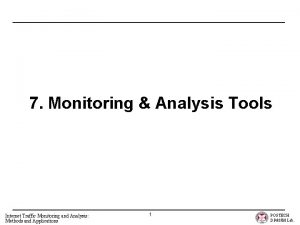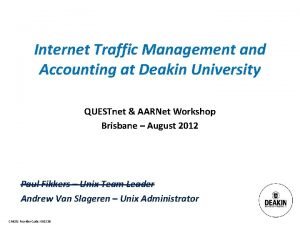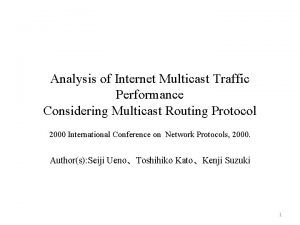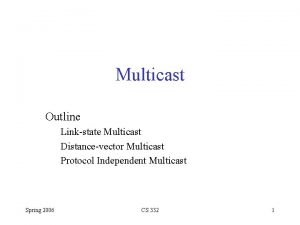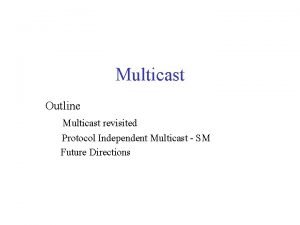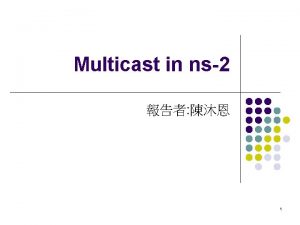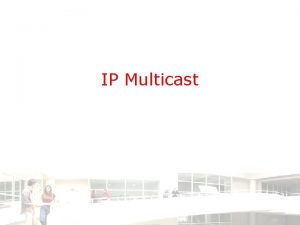Analysis of Internet Multicast Traffic Performance Considering Multicast












- Slides: 12

Analysis of Internet Multicast Traffic Performance Considering Multicast Routing Protocol 2000 International Conference on Network Protocols, 2000. Author(s): Seiji Ueno、Toshihiko Kato、Kenji Suzuki 1

Outline • Introduction • Overview of DVMRP – Performance Analyzer • Overview of PIM-SM – Performance Analyzer • Conclusion • Reference 2

Introduction • Recently, audio and video delivery services are widely spread in the Internet. • In order to deliver these data to multiple receivers at the same time, the multicast technologies are indispensable. • Multicast traffic is controlled by its own routing protocol and the multicast routing protocol is more complex than conventional unicast routing protocols. 3

Overview of DVMRP • First multicast routing protocol ever deployed in the Internet. • Each router maintains a ‘multicast routing table’ by exchanging distance vector information among routers. – Constructs a source tree for each group using reverse path forwarding. • There is a “designated forwarder” in each subnet – Multiple routers on the same LAN select designated forwarder by lower metric or lower IP address (discover when exchanging metric info. ) • Once tree is created, it is used to forward messages from source to receivers. 4

Overview of DVMRP(cont. ) • DVMRP uses a Broadcast & Prune mechanism. • DVMRP router does not have any members of a particular multicast group and any dependent downstream routers about the multicast group, it sends a Prune message to the upstream router to ask for stopping the forwarding of multicast IP datagrams of the multicast group. 5

Overview of DVMRP(cont. ) • Advantage Relatively simple – Modest processing demands • Disadvantage – Convergence performance – Periodically flood multicast traffic to rebuild its trees – scalability – 6

Performance Analyzer 7


Overview of PIM-SM(cont. ) • Advantages – Less traffic • disadvantages – Bottle-neck at an RP router – Single point of failure 9

Performance Analyzer 10

Conclusion • DVMRP – It can estimate the reasons for starting and stopping multicast datagram transmissions, such as sender's starting transmission or the prune timeout. • PIM-SM – It can estimate the multicast traffic changes between RPT (Rendezvous Point Tree) and SPT (Shortest Path Tree). 11

Reference • RFC-1112 -Multicast • RFC-1075 -DVMRP • RFC-2362 -PIM-SM 12
 Internet traffic tool
Internet traffic tool Incomina
Incomina All traffic solutions traffic cloud
All traffic solutions traffic cloud Internet traffic management
Internet traffic management Apache cdn configuration
Apache cdn configuration Holiday meal turkey ranch problem
Holiday meal turkey ranch problem Study the advertisement you are considering
Study the advertisement you are considering Rhetorical situations definition
Rhetorical situations definition Imperial jewelers is considering a special order for
Imperial jewelers is considering a special order for Johnny's lunches is considering purchasing a new
Johnny's lunches is considering purchasing a new You are considering buying some flowers
You are considering buying some flowers Considering interestrate swaps, the swap rate is
Considering interestrate swaps, the swap rate is Internet or internet
Internet or internet
